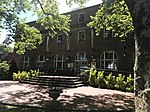Sailors' Snug Harbor

Sailors' Snug Harbor, also known as Sailors Snug Harbor and informally as Snug Harbor, is a collection of architecturally significant 19th-century buildings on Staten Island, New York City. The buildings are set in an 83-acre (34 ha) park along the Kill Van Kull in New Brighton, on the North Shore of Staten Island. Some of the buildings and the grounds are used by arts organizations under the umbrella of the Snug Harbor Cultural Center and Botanical Garden. Sailors' Snug Harbor was founded as a retirement home for sailors after Captain Robert Richard Randall bequeathed funds for that purpose upon his 1801 death. Snug Harbor opened in 1833 as a sailors' retirement home located within what is now Building C, and additional structures were built on the grounds in later years. The buildings became a cultural center after the sailors' home moved away in 1976. The grounds and buildings are operated by Snug Harbor Cultural Center and Botanical Garden, a nonprofit, Smithsonian-affiliated organization. Sailors' Snug Harbor includes 26 Greek Revival, Beaux Arts, Italianate and Victorian style buildings. Among those are "Temple Row", five interlocking Greek Revival buildings labeled A through E. The buildings are set in extensive, landscaped grounds, surrounded by the 19th-century cast-iron fence. The grounds also include a chapel and a sailors' cemetery. The cultural center includes the Staten Island Botanical Garden, the Staten Island Children's Museum, the Staten Island Museum, the Newhouse Center for Contemporary Art, and the Noble Maritime Collection, as well as the Art Lab and the Music Hall. The site is considered Staten Island's "crown jewel" and "an incomparable remnant of New York's 19th-century seafaring past." It is a National Historic Landmark District. Several buildings in the complex are New York City designated landmarks.
Excerpt from the Wikipedia article Sailors' Snug Harbor (License: CC BY-SA 3.0, Authors, Images).Sailors' Snug Harbor
Gazebo Road, New York Staten Island
Geographical coordinates (GPS) Address Nearby Places Show on map
Geographical coordinates (GPS)
| Latitude | Longitude |
|---|---|
| N 40.6425 ° | E -74.102777777778 ° |
Address
Herb Garden
Gazebo Road
10301 New York, Staten Island
New York, United States
Open on Google Maps







